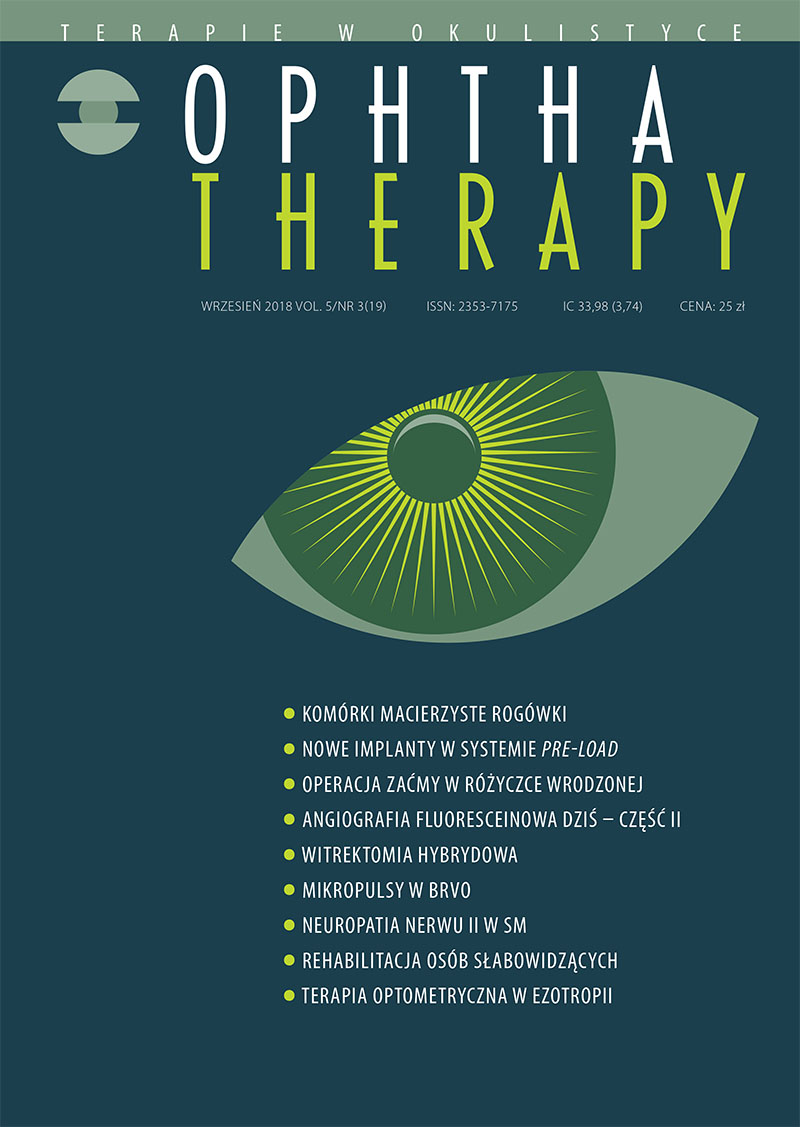Clareon® – a new generation of intraocular implants in the pre-loaded AutonoMe system
Main Article Content
Abstract
Innovation in the construction of artificial intraocular lenses has a major impact on the patient’s life comfort after cataract phacoemulsification surgery. In the times of intensive development of cataract surgery, the operator has the choice of the best implant option and the right treatment procedure. Lens production technology is a large area of research and a challenge for many manufacturers in terms of new biomaterials as well as their physical, mechanical and optical properties.
Downloads
Article Details

This work is licensed under a Creative Commons Attribution-NonCommercial-NoDerivatives 4.0 International License.
Copyright: © Medical Education sp. z o.o. License allowing third parties to copy and redistribute the material in any medium or format and to remix, transform, and build upon the material, provided the original work is properly cited and states its license.
Address reprint requests to: Medical Education, Marcin Kuźma (marcin.kuzma@mededu.pl)
References
2. Minami H, Torii K, Hiroi K et al. Glistening of the acrylic intraocular lenses. Rinsho Ganka. 1999; 53: 991-4.
3. Microvacuole Evaluation of Clareon and Other Marketed IOLs. Alcon internal report TDCO-0053516, effective February 28, 2017.
4. Łabuz G, Reus NJ, van den Berg TJ. Straylight from glistenings in intraocular lences: In vivo study. J Cataract Refract Surg. 2017; 43: 102-8.
5. Auffarth G, Schickhardt S, Wang Q et al. Laboratory evaluation of the new CLAREON hydrophobic acrylic IOL material: biomaterial properties and capsular bag behawior. Presentation at the ESCRS October 7–11, 2017, Lisbon.
6. Miyata A, Uchida N, Nakajima K et al. Clinical and experimential observation of glistening in acrylic intraocular lenses. Jpn J Ophthalmol. 2001; 45: 564-69.
7. Clareon and Marketed IOL Slit Lamp Surface Haze. Alcon internal technical report TDCO-0053487, effective February 28, 2017.
8. Imaging of the Usable Optic Diameter of Clareon® SY60WF, TECNIS ZCB00, and enVista MX60 IOLs. Alcon internal technical report TDOC-0053803, effective July 12, 2017.
9. Davison JA. Positive and negative dysphotopsia in patients with acrylic intraocular lenses. J Cataract Refract Surg. 2000; 26: 1346-55.
10. Clareon SY60WF Axial Displacement Study at Varied Compressions. Alcon internal technical report TDOC 0054028, effective July, 2017.
11. Imroved Milled Quality of Clareon IOLs. Alcon internal technical report TDOC-0053598, effective March 13, 2017.
12. Microvacuole Evaluation of Clareon and Other Marketed IOLs. Alcon internal report TDCO-0053516, effective February 28, 2017.
13. Werner L, Das K, Collins S et al. Model eye and in vitro assessment of positive dysphotopsia or glare types photic phenomena: a comparison of a new material IOL to other monofocal intraocular lenses. Presentation at the European Society of Cataract and Refractive Surgeons (ESCRS) annual meeting; October 7–11, 2011; Lisbon, Portugal.
14. Wiritsch MG, Findl O, Menapace R et al. Effect of haptic design on change in axial lens position after cataract surgery. J Cataract Refract Surg. 2004; 30: 45-51.
15. Koshy JJ, Nishi Y, Hirnschall N et al. Rotational stability of a single-piece toric acrylic intraocular lens. J Cataract Refract Surg. 2010; 36: 1665-70.
16. Nejima R, Miyai T, Kataoka Y et al. Prospective intrapatient comparison of 6.0-millimeter optic single-piece and 3-piece hydrophobic acrylic foldable intraocular lenses. Ophthalmology. 2006; 113: 585-90.
17. Lane SS, Burgi P, Milios GS et al. Comparison of the biomechanical behavior of foldable intraocular lenses. J Cataract Refract Surg. 2004; 30: 2397-2402.
18. Vasavada A, Singh R. Relationship between lens and capsular bag size. J Cataract Refract Surg. 1998; 24: 547-51.
19. Lane SS, Collins S, Das K et al. Evaluation of the mechanical behavior of a new single-piece intraocular lens as compared to commercially available IOLs. Presentation at the European Society of Cataract and Refractive Surgeons (ESCRS) annual meeting; October 7–11, 2017; Lisbon, Portugal.
20. Nozzle Preference and Delivery System Performance Study between AutonoMe and UltraSert. V3.5 Alcon internal technical report TDOC-0053876, effective 11 July 2017.

